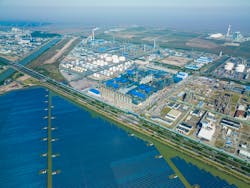The idea of industrial sustainability is hardly a new issue. For at least two decades, the push for industrial sustainability initiatives has focused on the bottom-line benefits sustainability can deliver through less waste and improved energy efficiencies. More recently we've seen heightened concerns about climate change from both the marketplace and the labor force driving industry even further toward more sustainable operations and practices.
To better understand the ever-evolving intersection of sustainability and automation, we connected with Michael Martinez, Foxboro DCS (distributed control systems) global leader at Schneider Electric, for a recent episode of the “Automation World Gets Your Questions Answered” podcast series.
We began our discussion by getting Martinez’s take on the current state of automation technologies in terms of how they're positioned to support industry’s digital transformation—a critical component of any industrial sustainability effort.
Looking across the economic, environmental, and social/human aspects of sustainability, we can start to see the more valuable and unique role of automation, he said, citing a recent report by Omdia which found that 94% of respondents believe that industrial digital transformation will have a moderate to high impact on their operations in the next two to three years, but only 55% of those respondents said the DCS and other automation systems they use are only “somewhat equipped” to support that digital transformation.
“The automation systems [most companies are using today] are not capable of achieving the business outcomes they’re after,” Martinez said. “But it is important to recognize that they see investing in these technologies will help them to achieve those [desired] outcomes. I think it's a double-edged sword in the sense that, yes, it's positive that industry sees technology making a vital impact on their operations; but the technology that many are using today is not ready to achieve those outcomes.”
Martinez said some of the biggest disconnects in the automation systems many companies currently use involve interoperability, connectivity, and cybersecurity concerns.
Closing the gaps with open systems
With these disconnects in mind, Martinez noted industry’s trend away from closed, proprietary systems and toward more open systems. Schneider Electric is supporting UniversalAutomation.org in this effort and Martinez explained how Schneider Electric sees the connection between the push toward open industrial software and sustainability.
“If you look at the two pillars of economic and environmental sustainability, software-centric automation enables you to decouple hardware and software to leverage best-in-class technology and get that technology applied into your processes faster to achieve the outcomes you're after,” he said.
According to Martinez, the idea of using non-proprietary systems that run on standards-based configuration tools to decouple hardware and software will “enable us to democratize innovation. And by that I mean we can get these tools to the masses so that they no longer have to live in the halls of PhDs and experts, enabling operations management and personnel to contribute their expertise to the industrial automation perspective,” he explained. “With this change, we’ll start seeing the best ideas winning because everybody can contribute, regardless of their location, in this more open, inclusive world of UniversalAutomation-based systems.”
The impact on sustainable operating processes
Explaining the connection between open systems and specific sustainability initiatives, Martinez said, “Historically, we've looked at optimization and reducing waste and consumption through our normal automation platforms, which can address economic and environmental sustainability factors. But being able to address emissions and the overall cost of running the operation helps us begin to see the future of a sustainable automation system.”
As an example, Martinez noted the ability to use runtime software on different types of hardware to flatten your network. Before open automation systems, users would have to integrate different systems with gateways and mapping tags. Now they can be integrated into one solution running one operating system with one application. This reduces the need for hardware, space, and energy.
“Having one common platform allows users to operate a facility throughout its manufacturing processes—from raw materials all the way to finished product, packaging, and shipment,” said Martinez. “That enables users to think about how to optimize skill sets. Being able to democratize innovation means that we can have skills and tools that more people have access to. And from an emissions and supply chain perspective, we can optimize procurement more easily to target more locally acquirable supplies. That’s how it becomes a whole different way of thinking about [the connection between] sustainability and automation systems; because it’s not just about what can be applied to [existing] processes, but how we design, configure, and use them to actually have a more sustainable impact.”
Leaders relevant to this article:



